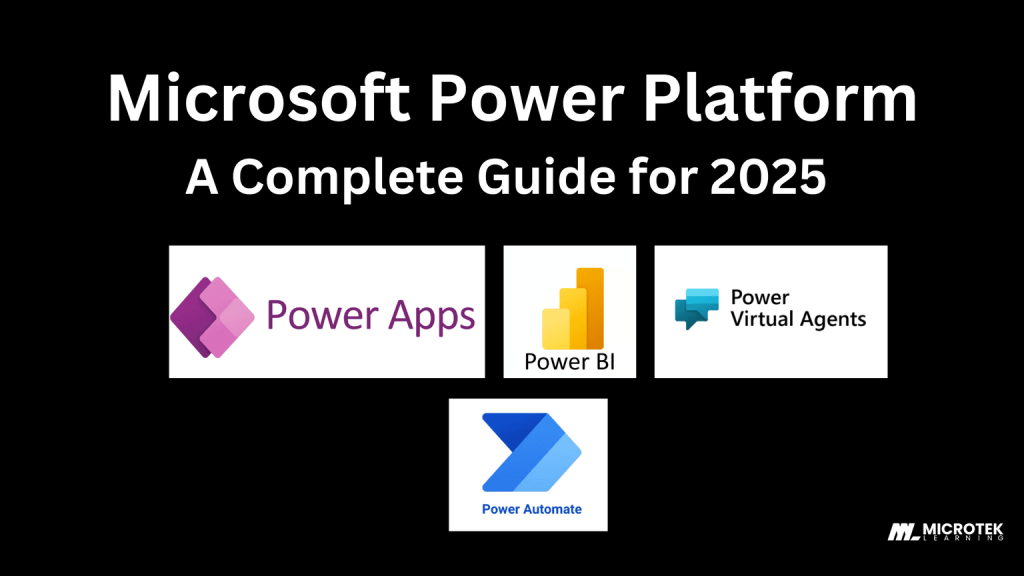
Microsoft Power Platform is a power bundle of various applications that allow you to automate, create, manage, build, and organize. The aim of introducing the Microsoft Power Platform lies in using all the data in order to harness insights and utilize the results for the advancement of the company.
In this blog, we will dive into learning about different components of Microsoft Power Platform, its integrated capabilities, and how it is one of the best options for creating a seamlessly integrated world for your organization. Let’s dive straight into it, shall we?
What is Microsoft Power Platform: In Simpler Terms
Microsoft Power Platform is a collaborative platform introduced by Microsoft launched in 2018. This platform is known for its low-code tools that help build and automate procedures quickly. Power Platform is highlighted as intuitive and highly accessible for daily tasks in any size of business. This results in providing a dynamic space for finding solutions and accelerating business growth.
The primary goal of this platform is to provide an environment to the teams so that they can build applications that do not take months or a lot of development work to create. With the help of minimalistic code, this application includes logic for your business and can be used on various devices as well. Various devices include Android and iOS operating systems, as well as on the web, laptops, and tablets.
Another robust feature of this platform includes integration into Microsoft Cloud Services, such as Azure Cloud, Microsoft 365 suite, and Dynamics 365 CRM.
Microsoft Power Platform includes four components: Power BI, Power Apps, Power Automate, Power Pages, and Dataverse.
Microsoft Power Platform: Components
Now that we are aware of what exactly Microsoft Power Platform is all about, let’s explore its core components a little further and learn more about their functions. Power Platform includes multiple components that are specifically designed to solve business problems while providing positive outcomes.
Power Apps
Power Apps specializes in allowing users to build custom applications that provide advanced business solutions. This application consists of a low-code, minimal level of coding and is known for its drag-and-drop interface while connecting to various data sources like Microsoft 365, Dynamics 365, and SQL servers. This application is also one of the products that is enabled for both developers and non-technical users.
Business users utilizing power apps can build various types of apps. There are two most popular types: canvas apps and model-drive apps. This application also combines self-service analytics, while Microsoft Azure is a cloud host to it. This means that it is well connected with platforms such as SharePoint and Microsoft Dataverse.
Key features of Power Apps
Low code development: This is a primary feature for Power Apps, making it easy to use and ready to be included in any level of project with any field of professionals. This is possible because it works with quickly understandable interface and no-code building designs.
Business Logic and Workflows: Having integrated options within the application for complex business logic and workflows helps Power Apps to be approachable for business solutions.
Data Connectivity: With Power Apps, one does not need to worry about connecting to various applications in order to find the results and analyze the data. This application makes sure to include data sources, including Microsoft Dataverse, on-premises sources, and other online platforms that help find effective outcomes.
Power Automate
Power Automate platform’s primary goal is to help professionals build and create automated workflows across multiple applications. Its creativity lies in it, which can help build everything without the help of writing code.
This application aims to provide integrated and synchronized data analysis in an automated way. It also allows you to connect to other third-party applications in order to automate business processes.
Key features of Power Automate
No Code Required: Power Automate is equipped with a visual drag-and-drop interface. This simply means that it can be accessed and utilized by anyone who does not necessarily have a background in coding.
Pre-Built Templates: Power Automate consists of pre-built templates that are already ready to use. These are used for sending notifications, updating data across the system, or approving documents.
AI Capabilities: The AI feature is an embellishment for Power Automation. This helps in making complex tasks simpler. Features like AI Builder can be used to extract data from documents. This can be further utilized to gain powerful insights and make further decisions based on it.
Power BI
Power BI is widely known for its ability to allow users to visualize data from multiple sources. This includes creating dashboards and reports, gaining insights, and making data-driven decisions.
Power BI is considered to be a popular choice for business solutions as it is able to share reports across teams while transforming raw data into actionable insights. This application also helps enhance collaborations, scale large datasets, and improve visibility by accessing real-time data through dashboards.
Key features of Power BI
User-Friendly Interface: The drag-and-drop interface of this platform makes it simple and easy for users to create visualizations and reports without the hassle of coding.
Data Analysis Capabilities: Power BI has the functionality of data analysis expressions (DAX). This feature is utilized for data manipulation and advanced calculations.
Collaboration Options: This feature helps teams to stay connected on various levels while having the same amount of information in real-time. One can easily share reports and conduct discussions around key metrics simultaneously across different teams.
If you are someone looking to learn Power BI from scratch to the core, we can help you in your journey. To know more, click here.
Power Pages
Just like other components, Power Pages is also a low-code, cloud-based platform that helps create and manage business websites with nominal coding. While utilizing the pre-built templates and designing responsive pages, this application is built to provide business solutions at multiple levels.
Microsoft Power Pages is a Saas (software as a service) platform that excels in hosting and administering modern external-facing business websites. This platform empowers you to rapidly design, publish, and configure across web browsers.
Key features of Power Pages
Data Integration: Power Pages helps in providing seamless integration with Microsoft Dataverse. This allows users to collect data from their current business and further create their website content.
Security: This platform has dynamic options to control access on various levels for specific areas of the website.
Integration: Power Pages is ideally integrated with other Power Platform components. These include apps and applications like Power Apps and Power Automate. Combining all these together results in creating a comprehensive business solution.
Dataverse
Dataverse refers to a cloud data service that acts as a central repository for Microsoft Power Platform Applications. This platform allows data to be stored, accessed, and managed across multiple applications like Dynamics 365.
This platform also has specific features like storing data in tables and columns. It also consists of robust security levels that include features like role-bases and row/column-based access.
Key features of Dataverse
Customization: Dataverse leverages the option of the common data model. This helps in standardizing entities and attributes. There are pre-build tables that help with concepts like accounts, products, and consumers as well.
Integration with Power Platform: Dataverse fits into the bar of Power Platform, as it is strongly integrated with other components. This opens doors for exploring a wide range of opportunities in order to complete the task on time.
Security Features: Dataverse has inbuilt granular security features that include access control at minor parts like role-based and column levels. This gives users the benefit of restricting data access as required while being active on user-based permissions.
Microsoft Power Platform: What’s new in 2025?
Being aware of the whole package being provided by Microsoft Power Platform, it is hard to resist the fact that it does have the required tools and technology that can help you find business solutions.
With a glance, Microsoft, being the provider of the pack, isn’t holding back with something new in every wave. Taking Wave 1 into the update, Power Apps have visible highlights.
AI Power: Microsoft has introduced an AI-powered assistant that acts like a co-pilot and helps in solving challenges step-by-step. This feature helps you in tasks like suggesting layouts, components, and other functionalities that are based on natural prompts.
Web Agents: Power Pages now has 24/7 support for artificial intelligence, such as “Web Agents,” which will help consumers by providing chat support via email or even WhatsApp.
Complex to Easy: Power Automation will now be able to streamline approvals, crunch data, and auto-general documents. This would make security management easy and directly contribute to scaling projects.
Integration: Dataverse has now improved its AI workflow. This simply means gaining insights from external and internal databases to find better solutions.
Security Update: Microsoft has paid intense attention to the importance of security for businesses. This time, they upgraded admin tools, which would help automate governance tasks and enforce compliance at scale.
Conclusion
Microsoft Power Platform is an ecosystem designed for business solutions. With its low code approach and user-friendly interface, it is adaptable and customizable for any size of business.
In 2025, Microsoft again proved its core understanding of consumer requirements and pushed its boundaries. With improvements being presented in the first Wave, like AI-driven assistants, enhanced security measures, and improved governance features, Power Platform is one of the most approachable platforms for finding tailored solutions.
With growing technologies around, Power Platform still remains a key player in providing customized solutions. It doesn’t matter whether you are a startup looking for cost-effective solutions or an established enterprise that is ready to upskill its current understanding of business solutions; Power Platform is your answer.
FAQ
What is Microsoft Power Platform?
Microsoft Power Platform is a low-code platform that helps in building, managing, and creating customized solutions for end-to-end business.
Is Power Platform a good career?
The answer is YES, Power Platform is a good choice for choosing a career, as the demand and versatility of this platform are on the high rise.
Is Microsoft Power Platform free?
Yes, Microsoft Power Platform does provide a limited-edition free trial and a free developer plan.
What is the purpose of Microsoft Power Platform?
Microsoft Power Platform helps in building applications, automating workflow, and analysing data. Overall it is an ecosystem that provides tailored business solutions.
What are the 4 components of Power Platform?
The four components of Power Platform include Power Apps, Power Automate, Power BI, and Power Virtual Agent. These components work together with Dataverse, extension capabilities, and Azure services.
What are the responsibilities of Power Platform?
The responsibilities of Power Platform include:
- Developing and implementing customized solutions
- Staying up to date with the latest Power Apps
- Automating workflows and business processes
Is Power Platform a Saas or Paas?
Microsoft Power Platform is Software as a Service (Saas).
Who uses Microsoft Power Platform?
Microsoft Power Platform is a celebrated name in the Saas industry, in order to provide customized solutions. Top organizations like Deloitte and PwC use this platform.
What is new in Power Platform?
With the new wave 1 release in 2024, Microsoft Power Platform has hundreds of new features. These features have been updated in applications like Power BI, Power Pages, Microsoft Dataverse, and Power Automate.
What problems does Power Platform solve?
Microsoft Power Platform is known for providing tailored solutions. This platform gives customized solutions for business intelligence, time challenges, budgetary challenges, lack of visibility, and integration challenges.



